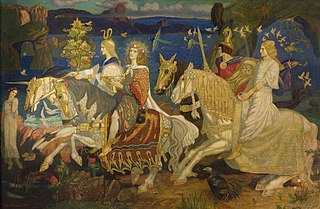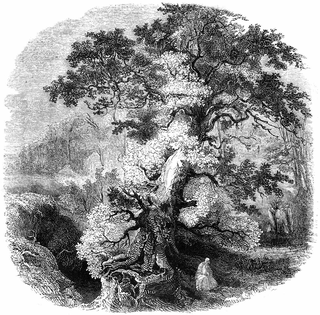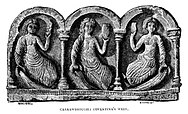
The TuathaDé Danann, also known by the earlier name Tuath Dé, are a supernatural race in Irish mythology. Many of them are thought to represent deities of pre-Christian Gaelic Ireland.
Cormac mac Airt, also known as Cormac ua Cuinn or Cormac Ulfada, was, according to medieval Irish legend and historical tradition, a High King of Ireland. He is probably the most famous of the ancient High Kings, and may have been an authentic historical figure, although many legends have attached themselves to him, and his reign is variously dated as early as the 2nd century and as late as the 4th. He is said to have ruled from Tara, the seat of the High Kings of Ireland, for forty years, and under his rule, Tara flourished. He is credited for building many of the monuments at the Hill of Tara such as the Banqueting Hall, Cormac's house, and Gráinne's Enclosure, named after his daughter. He was famous for his wise, true, and generous judgments. In the Annals of Clonmacnoise, translated in 1627, he is described as:
"absolutely the best king that ever reigned in Ireland before himself...wise learned, valiant and mild, not given causelessly to be bloody as many of his ancestors were, he reigned majestically and magnificently".

Manannán or Manann, also known as Manannán mac Lir, is a sea god warrior and king of the Otherworld in Irish and Manx mythology who is one of the Tuatha Dé Danann.

Lir or Ler is a sea god in Irish mythology. His name suggests that he is a personification of the sea, rather than a distinct deity. He is named Allód in early genealogies, and corresponds to the Llŷr of Welsh mythology. Lir is chiefly an ancestor figure, and is the father of the god Manannán mac Lir, who appears frequently in medieval Irish literature. Lir appears as the eponymous king in the tale The Children of Lir.
In Irish mythology, Mag Mell is one of the names for the Celtic Otherworld, a mythical realm achievable through death and/or glory. Unlike the underworld in some mythologies, Mag Mell was a pleasurable paradise, identified as either an island far to the west of Ireland or a kingdom beneath the ocean. However, Mag Mell was similar to the fields of Elysium in Greek mythology, and, like the fields of Elysium, was accessible only to a select few. Furthermore, Mag Mell, like the numerous other mystical islands said to be off the coast of Ireland, was never explicitly stated in any surviving mythological account to be an afterlife. Rather, it is usually portrayed as a paradise populated by deities, which is occasionally visited by some adventurous mortals. In its island guise it was visited by various Irish heroes and monks forming the basis of the Adventure Myth or "echtrae" as defined by Myles Dillon in his book Early Irish Literature. This otherworld is a place where sickness and death do not exist. It is a place of eternal youth and beauty. Here, music, strength, life and all pleasurable pursuits come together in a single place. Here happiness lasts forever, no one wants for food or drink. It is the Irish equivalent of the Greek Elysium or the Valhalla of the Norse.
The Enbarr (Énbarr) or Aonbharr of Manannán is a horse in the Irish Mythological Cycle which could traverse both land and sea, and was swifter than wind-speed.
The Voyage of Bran is a medieval seventh- or eighth-century Irish language narrative.

In Celtic mythology, the Otherworld is the realm of the deities and possibly also the dead. In Gaelic and Brittonic myth it is usually a supernatural realm of everlasting youth, beauty, health, abundance and joy. It is described either as a parallel world that exists alongside our own, or as a heavenly land beyond the sea or under the earth. The Otherworld is usually elusive, but various mythical heroes visit it either through chance or after being invited by one of its residents. They often reach it by entering ancient burial mounds or caves, or by going under water or across the western sea. Sometimes, they suddenly find themselves in the Otherworld with the appearance of a magic mist, supernatural beings or unusual animals. An otherworldly woman may invite the hero into the Otherworld by offering an apple or a silver apple branch, or a ball of thread to follow as it unwinds.
In Irish mythology, Tír na nÓg or Tír na hÓige is one of the names for the Celtic Otherworld, or perhaps for a part of it. Tír na nÓg is best known from the tale of Oisín and Niamh.

The golden apple is an element that appears in various national and ethnic folk legends or fairy tales. Recurring themes depict a hero retrieving the golden apples hidden or stolen by a monstrous antagonist. Gold apples also appear on the Silver Branch of the Otherworld in Irish mythology.

An immram is a class of Old Irish tales concerning a hero's sea journey to the Otherworld. Written in the Christian era and essentially Christian in aspect, they preserve elements of Irish mythology.
An Echtra or Echtrae, is a type of pre-Christian Old Irish literature about a hero's adventures in the Otherworld or with otherworldly beings.

Apples appear in many religious traditions, often as a mystical or forbidden fruit. One of the problems identifying apples in religion, mythology and folktales is that as late as the 17th century, the word "apple" was used as a generic term for all (foreign) fruit other than berries, but including nuts. This term may even have extended to plant galls, as they were thought to be of plant origin. For instance, when tomatoes were introduced into Europe, they were called "love apples". In one Old English work, cucumbers are called eorþæppla, just as in French, Dutch, Hebrew, Afrikaans, Persian and Swiss German as well as several other German dialects, the words for potatoes mean "earth-apples". In some languages, oranges are called "golden apples" or "Chinese apples". Datura is called "thorn-apple".
Mongán mac Fíachnai was an Irish prince of the Cruthin, a son of Fíachnae mac Báetáin. Little is certainly known of Mongán's life as only his death is recorded in the Irish annals. He appears as a character in the Cycles of the Kings where he is said to have been the son of Manannán mac Lir and perhaps a reincarnation of the legendary hero Finn mac Cumaill of the Fenian Cycle.

Many types of trees found in the Celtic nations are considered to be sacred, whether as symbols, or due to medicinal properties, or because they are seen as the abode of particular nature spirits. Historically and in folklore, the respect given to trees varies in different parts of the Celtic world. On the Isle of Man, the phrase 'fairy tree' often refers to the elder tree. The medieval Welsh poem Cad Goddeu is believed to contain Celtic tree lore, possibly relating to the crann ogham, the branch of the ogham alphabet where tree names are used as mnemonic devices.
Egerton MS 1782 is the index title of an early sixteenth-century Irish vellum manuscript housed in the Egerton Collection of the British Library, London.
The Expulsion of the Déisi is a medieval Irish narrative of the Cycles of the Kings. It dates approximately to the 8th century, but survives only in manuscripts of a much later date. It describes the fictional history of the Déisi, a group that had gained political power in parts of Ireland during the Early Middle Ages. Part of the text's purpose is to provide the kings of the Déisi – historically the descendants of unlanded vassals to other tribes – with a mythical noble origin as the heirs to a dynasty expelled from Tara.

Echtra Condla, is an Old Irish echtra tale known in two variants from eight manuscripts, the earliest of which has been dated to the 12th C. – the tale may have been written down first as early as the 8th C. The two variants do not diverge sharply from one another, so that a single summary suffices for both.

Echtra Cormaic or Echtra Cormaic i Tir Tairngiri is a tale in Irish mythology which recounts the journey of the high-king Cormac mac Airt to the Land of Promise resided by the sea-god Manannán mac Lir.

The Land of Maidens is a motif in Irish mythology and medieval literature, especially in the chivalric romance genre. The latter often also features a castle instead of an island, sometimes known as the Castle of Maidens.










